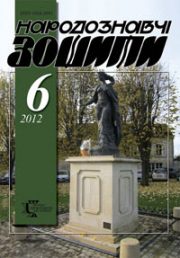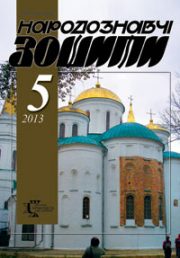The Ethnology Notebooks. 2023. № 3 (171), 623—658
UDK 930.2:[398.4(477.51)
DOI https://doi.org/10.15407/nz2023.03.623
HALAICHUK Volodymyr
- ORCID ID: https://orcid.org/0000-0001-7780-5876
- Doctor of Science in the field of History,
- Professor of the Department of Ethnology,
- Ivan Franko National University of Lviv,
- 1, Universytetska Str., 79000, Lviv, Ukraine,
- Contacts: e-mail: halay_czuk@ukr.net
Abstract. Statement of the problem. Demonology, worldviews and beliefs still remain vivid manifestations of the spiritual culture of Eastern Polissia. Despite the relatively good coverage of this topic on the pages of specialized scientific and local history publications, certain areas are little known in this context for researchers and a wide range of readers. In particular, this applies to the Ripkynsky district of the Chernihiv region.
The purpose of the research is to introduce into scientific circulation, systematize and analyze a mass of information about the demonological and worldview ideas and beliefs of Ripkynshchyna, in July-August 2017.
Traditional ideas about mermaids, hobgoblin and witches are considered.
The article presents a wide array of materials about people who seem to possess magical powers. Among them were those who were able to stop a fire, heal from a disease or snake bite, predict the future, etc. Instead, there were those who did harm: they tied magic knots on grain, took milk from cows, etc.
Demonological ideas related to the dead are considered: the belief that the deceased can «take away» something from the household after death; magical use of funeral attributes; ideas about dead children without baptism.
Samples of demonological and philosophical ideas about animals and plants, natural objects and phenomena are given: in particular, about a weasel and a snake, an aspen, trees with anomalies, the sun, thunder, drought, a whirlwind, etc.
It has been established that worldview and demonological ideas, beliefs from Ripkynshchyna are based on the all Polissian and, more broadly, on the all-Ukrainian basis, and at the same time contain a number of original fragments. Among these: certain features of «Mermaids’ Farewells» (such as banishing mermaids from the rye); the popular plot about how a witch «saddles» a late passer-by; some ways to ease the witch’s agony; the idea of a waterman and werewolves; legend from Great Axis about the «lady with a golden throat»; ways to prevent the deceased from «taking away» anything from the household; a way to end the drought by pouring borscht stolen from the neighbors into the well, etc.
The expediency of further ethnographic studies of Eastern Polissia has been determined.
Keywords: Eastern Polissia, demonology, worldviews and beliefs, mermaid, hobgoblin, witch, souls of the dead.
Received 11.05.2023
RЕFЕRЕNCЕS
- Vinogradova, L.N., & Levkiyevskaya, Е.Е. (Eds.). (2010, 2012, 2016, 2019). Folk demonology of Polissya: publication of texts in records of the 80—90 s. twentieth century (Vol. 1: People with supernatural powers; Vol. 2: Demonologization of dead people; Vol. 3: Mythologization of natural phenomena and human states; Vol. 4: Spirits of home and natural space. Non-localized characters (Studia philologica). Moskva [in Russian].
- Archive DNCZKSTK. F. Ripky-2017. Op. save V. Halaichuk [in Ukrainian].
- Halaіchuk, V. (2019). Demonology of Chernihiv Region (Based on field materials from Chernihiv District). Folk culture of the Chernihiv district (tradition and modern living conditions) (Pp. 154—168). Zhytomyr [in Ukrainian].
- Halaіchuk, V. (2022). Demonological and worldwide ideas and beliefs of the polishchuks of Chernihiv region (According to field materials from Novhorod-Siversky district). The Ethnology notebooks, 5 (167), 1092—1120 [in Ukrainian].
- Halaіchuk, V. (2022). Demonological and worldwide ideas and beliefs of the polishchuks of Chernihiv region (According to field materials from Semenivsky district). The Ethnology notebooks, 6 (168), 1300—1332 [in Ukrainian].
- Halaіchuk, V. & Tsypyshev, S. (2019). Traditional calendar and household customs and rites of Eastern Polissia (According to field materials from Ripkynsky district). The Ethnology notebooks, 5 (149), 1305—1330 [in Ukrainian].







